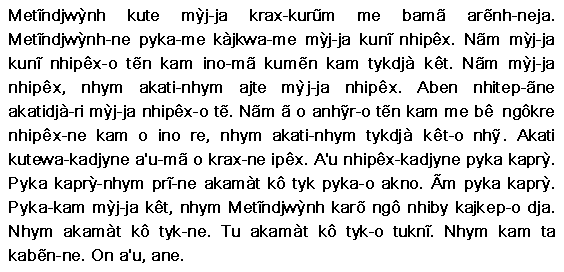
The Kayapo have a patriarchal society in which they believe that the women's place is to have children and prepare body paint for the men. The men's place in this society is to collect and find the food. Men have certain privileges that women do not, such as the right to enter the central hut in the villages where business is conducted. Men also are allowed to take multiple wives - usually 2 or 3 - to increase the number of offspring a male has.
The Kayapo view anything that they dislike as weak, and in turn, feminine. The over consumption of material goods falls under these categories to the Kayapo. The correlation of femininity and weakness reflects the male dominance this society exudes.
Everything a woman does is seen as less than anything a man does. Even the everyday tasks of women are seen as secondary to men's because the men is the provider of the goods to perform these tasks. Most of the women's activities involve having young children nearby for them to take care of; the men do little in raising their very young. Because most of their tasks involve these young, child rearing is seen as a feminine, and therefore, weak task, meaning that having babies is weak. This view further allows men to exert their control over all aspects of a woman's life, including her sexuality.
Acts of sexual violence are common among the Kayapo. Rape is seen as socially acceptable in ritual and spiritual ceremonies. A woman's rite of passage when she reaches puberty is to go into the forest with older men and have sexual intercourse with them all. Collective rape is also used as punishment for women who break ritual rules, such as coming too close to the central hut when a ceremony is taking place.
Sources:
Popvic, M. 2011. Kayapo. Tradtions and Customs From All Over the World.
http://traditionscustoms.com/people/kayapo?page=2
Turner, T. 2003. The Beautiful and the Common: Inequalities of Value and Revolving Hierarchy among the Kayapo.
http://digitalcommons.trinity.edu/cgi/viewcontent.cgi?article=1002&context=tipiti






.jpg)














